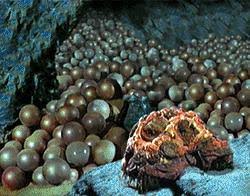I'm going to assume by 'thermal-like' you mean actually thermal energy, and you'll just claim the heat as a side-effect of this new energy type.
The only cases that can 'constantly' emit heat are minerals with high radioactive contents. Those are dangerous of course, but if you can find some way to make them plentiful and say that the native life in this world has evolved natural radiation resistance far better than our own, it might work. Plain mineral forms tend to not emit much heat, but pure forms of some radioactive metals emit so much heat that they glow red-hot (and some simultaneously fluoresce from their own radiation).
Other options that work on much shorter time-scales:
- Minerals which exhibit exothermic oxidation. Pyrite (iron(II) disulfide, also known as fool's gold) is probably the easiest example. Under normal atmospheric conditions, it oxidizes (very slowly) into rust (mostly iron(III) oxide)) and sulfur oxides (mostly sulfur trioxide, which is slightly dangerous as it will produce sulfuric acid in any nearby water). Another reasonably common example is arsenopyrite (iron(II) diarsenide), though that's a bit more dangerous because it produces toxic arsenic compounds when it oxidizes. Both of these produce a small amount of heat when they oxidize. The process can be sped up (and the heat increased a bit) by increasing the surface area of the minerals, or by increasing the humidity of oxygen content of the air they are in.
- Hygroscopic minerals which exhibit exothermic dissolution in water. There are very few of these in real-world geology, all of them are ionic metal salts, and all of them are rare. If you're willing to mess with geology a bit, you could use oxides of alkali-earth metals for this though. Calcium oxide is an easy example, it can easily produce temperatures in excess of 300 degrees celsius while dissolving (enough to things on fire or cause some pretty nasty burns), though it does produce a rather caustic solution of calcium hydroxide (which can easily produce some pretty nasty burns of the chemical variety instead of the thermal variety).
- Fluorescence in the infrared region. Quite literally, stuff that radiates heat when it fluoresces. I don't know of any minerals that exhibit this to any significant degree in real life, but it's been demonstrated in synthetic compounds before. Most likely, it would end up being a case of a mildly radioactive mineral that self-fluoresces, probably with some associated fluorescence in the visible light spectrum too (if you make the visible component narrowband, that could then be the 'color of life' in your world).
Of course, you could also just pick a real-world mineral that already meets your other criteria, and just attribute this new effect to it as well. Gemstones may work well for this, because they can then also be processed by your people into nice looking decorations (and that may improve or reduce their ability to emit this life energy), and true gem-quality samples are rare for most of the 'classic' gemstones.
Prasiolite might make an interesting choice if you go with this approach, it has rather beautiful pale green crystals, it's rather durable (it's a particular variety of quartz), it's pretty rare in nature in real life (but your geology could be just different enough that it's more common), and less scrupulous people can produce synthetic prasiolite by heat-treating amethyst. You could have a whole aspect to it where natural samples are far better at producing life energy, so they are significantly more valued, and some countries might have laws against producing and/or selling synthetic specimens.

